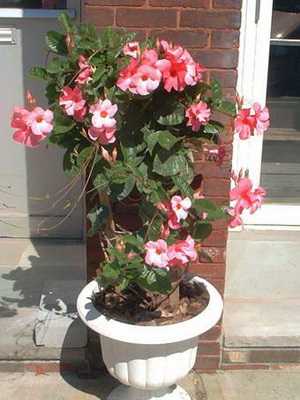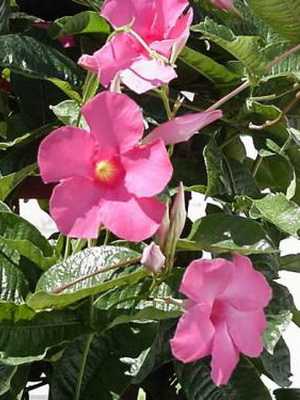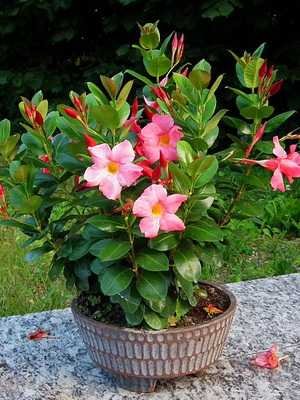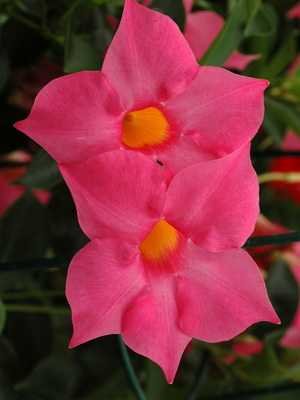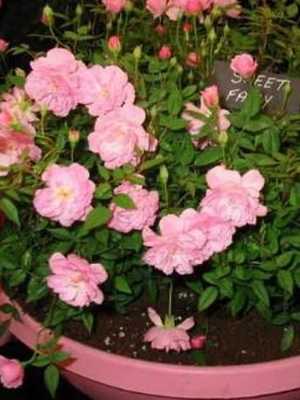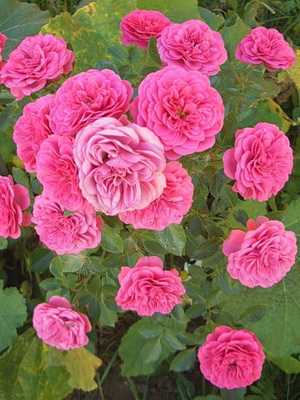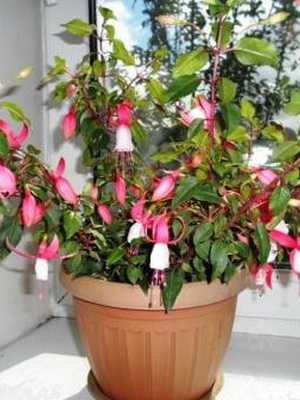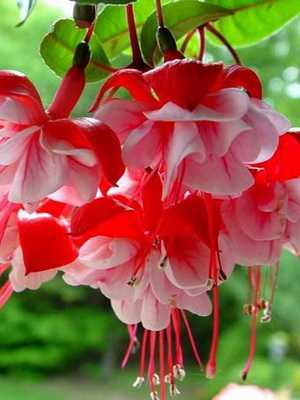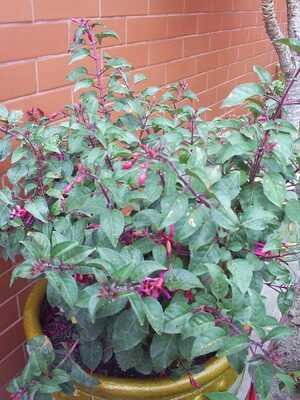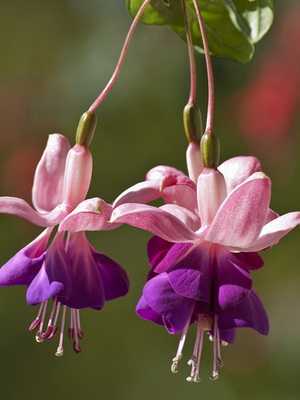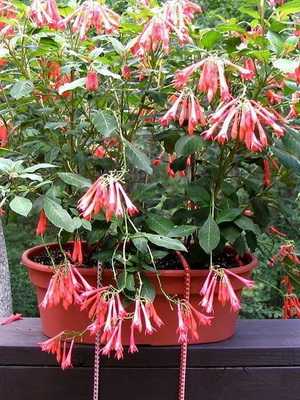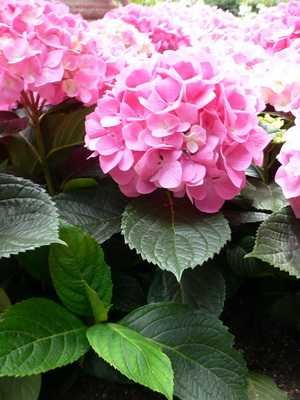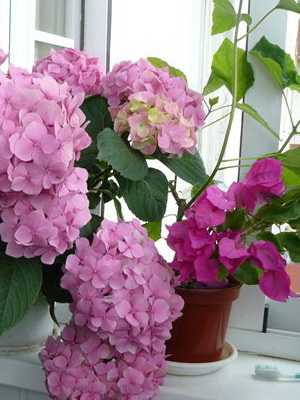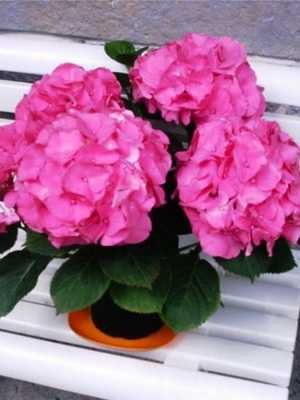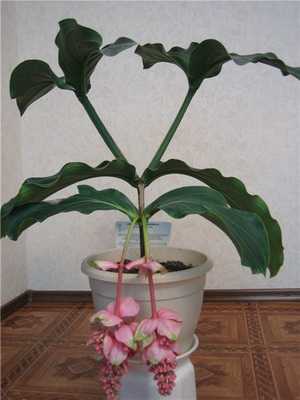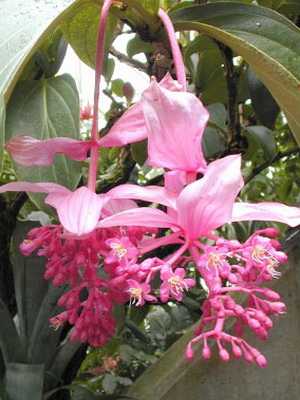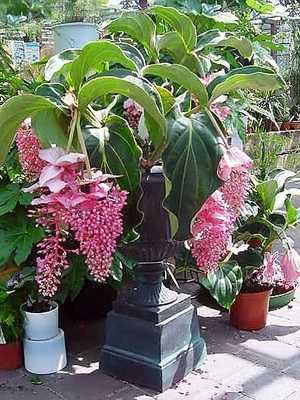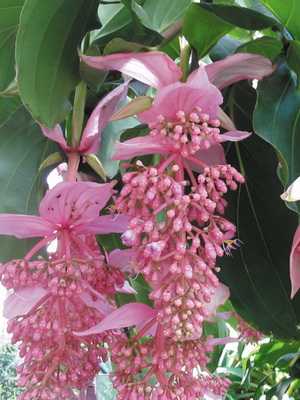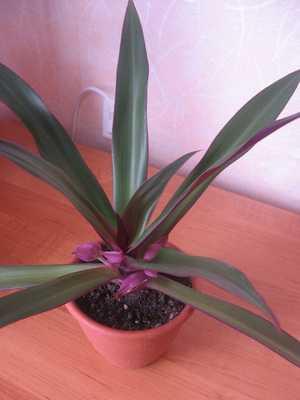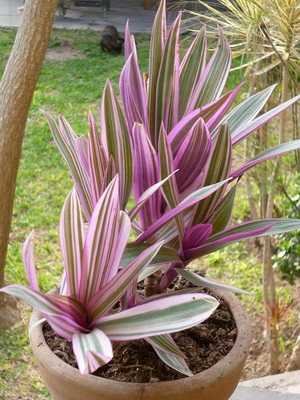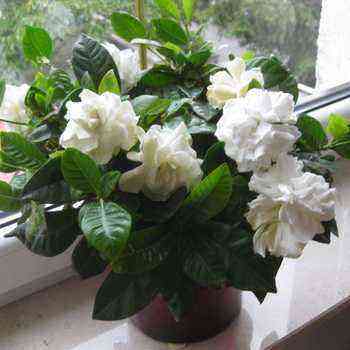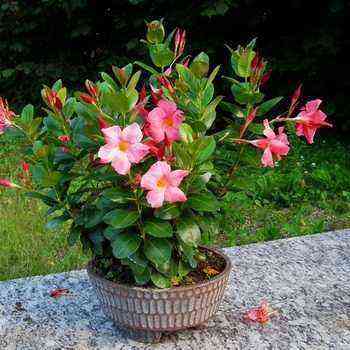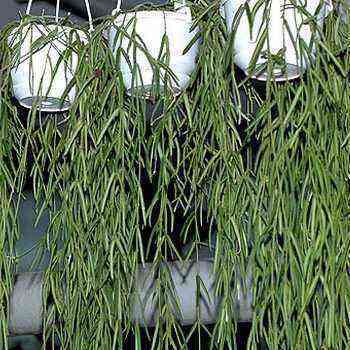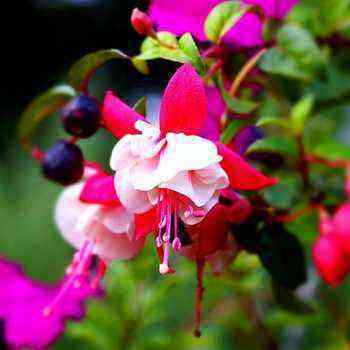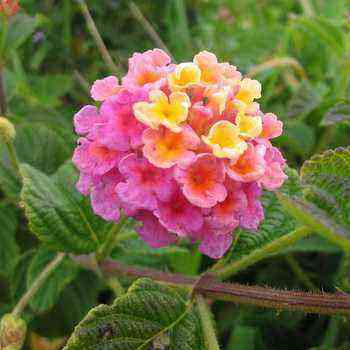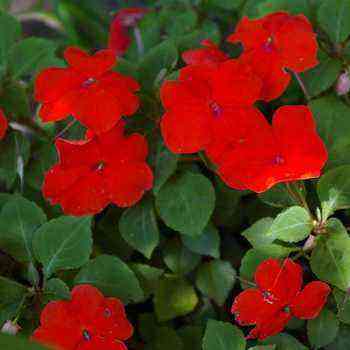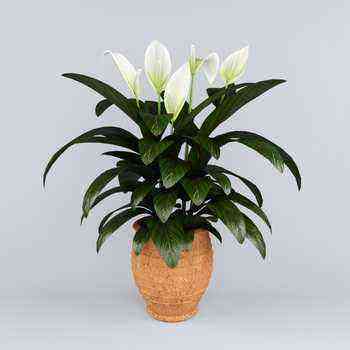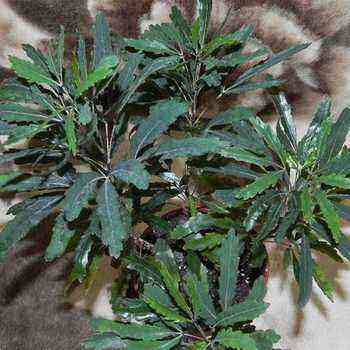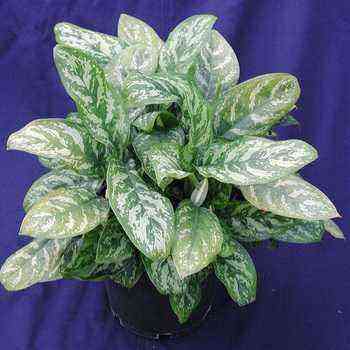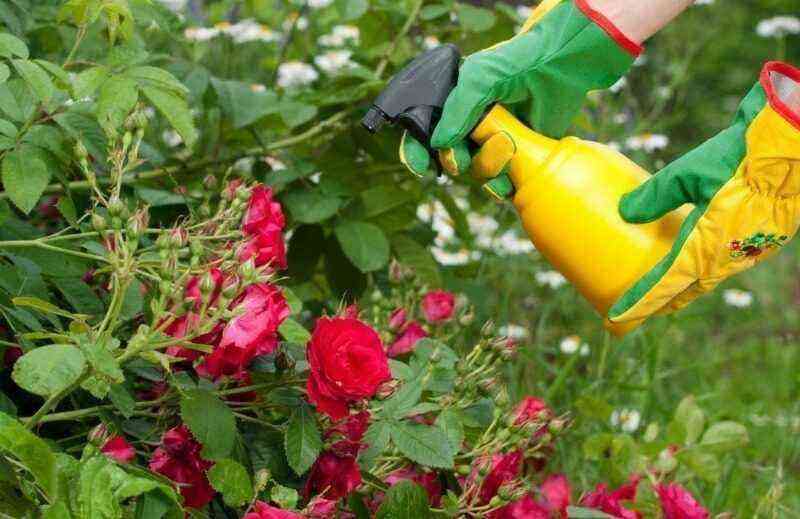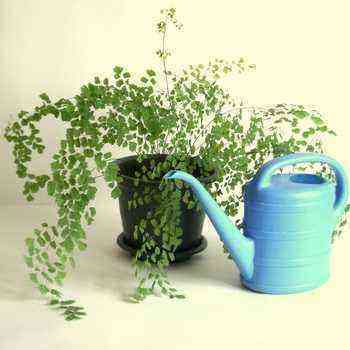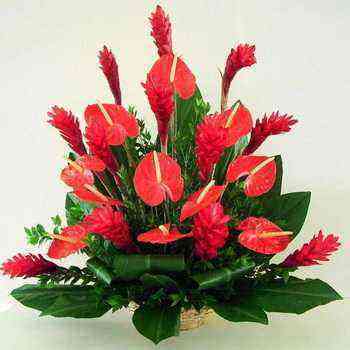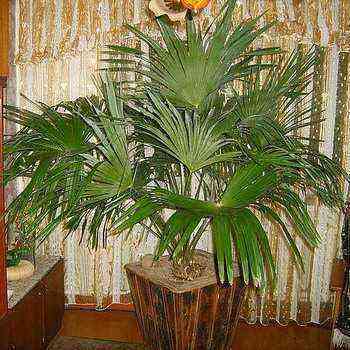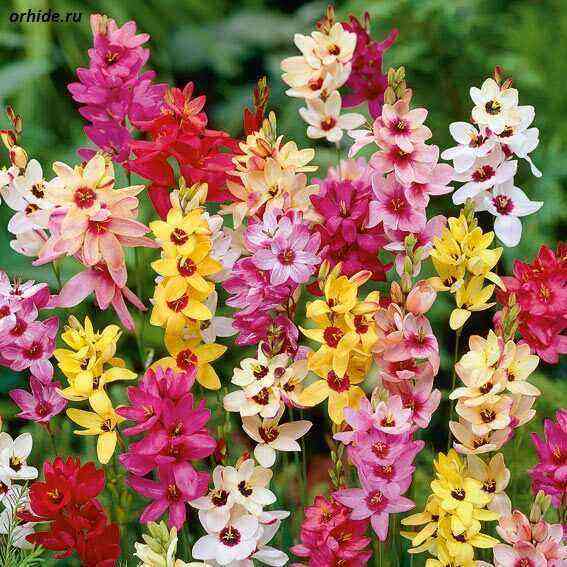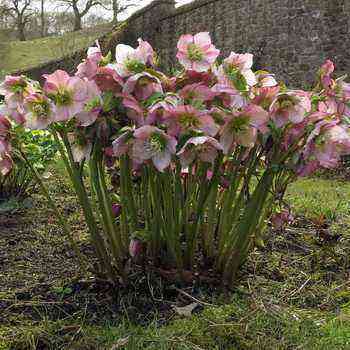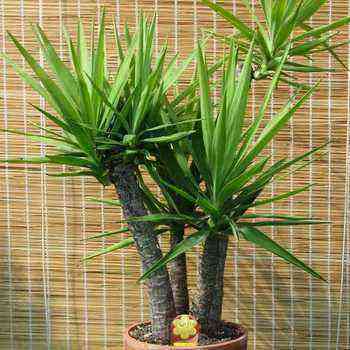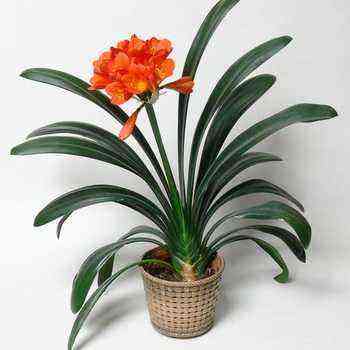
We bring to your attention a description and photo of pink flowers: mandeville, rose, fuchsia, medinilla hydrangea and reo. You can also read the recommendations for caring for pink flowers. In addition, after reading this article, you will learn how to propagate indoor flowers with pink flowers at home.
Indoor flower pink mandeville
Large pink flowers on MANDEVILLA appear on climbing stems in summer. This plant can be grown as an indoor liana, reaching 3 m or more, or pruned after flowering to maintain the bushy shape of the flower. Pink flowers appear on the plant while it is still small, and the shiny leaves make it attractive all year round.
Mandeville, or to Sander’s diploma (Mandevilla, or Dipladenia sanderi rosea), grown for its pink flowers with a yellow eye.
У mandeville brilliant (M. splendens) the leaves are larger, and the flowers are with a pink neck.
Mandeville indoor flower care with pink flowers
Temperature: Heat – minimum 13 ° C in winter.
Shine: Bright light or partial shade without direct sunlight.
Watering: Water regularly from spring to fall. Water sparingly during the winter.
Air humidity: Spray the foliage regularly, especially when the plants are in bud or in bloom.
Transfer: Repot in the spring annually.
Reproduction: Stem cuttings in spring. Use rooting hormones and substrate warming.
Rose flower: flower with pink flowers
Miniature Rose (ROSA) when growing in a room, they have special needs. Follow the guidelines below and repot and move your plants outdoors in the fall. Bring back before the cold weather sets in, cut the top half of the stems and put them in a permanent place in the room.
Miniature roses are rose hybrids Chinese smallest (Rosa chinensis minima)blooming from spring to late summer. Look for rose varieties 30 cm or less and plants grown from cuttings.
Caring for flowers with pink flowers
Temperature: Moderate — Keep at 10-21 ° C during the growing season.
Shine: As much light as possible – a solar window fits perfectly.
Watering: Indoor flowers with pink flowers should be watered abundantly. Let the soil dry slightly between waterings.
Air humidity: Spray the foliage frequently.
Reproduction: Stem cuttings in early spring – use rooting hormones.
Fuchsia pink flowers and their photos
Fuchsia (FUCHSIA) blooms from spring to autumn. F. hybrida (F. hybrida) has bell-shaped flowers, and the flowers of lesser-known F. triphylla hybrids have a tubular shape. Most plants are thrown away immediately after flowering, but you can let them overwinter in a cool place; cut off the stems in early spring. In young plants, the tips of the stems are pinched to obtain a dense crown.
The bushes have a height of 30 cm to 1 m. As you can see above in the photo, pink flowers of fuchsia hybrid (Fuchsia hybrida) can be simple, semi-double or double.
У fuchsia three-leaf (F. triphylla) flowers are pink, orange or red. There are ampelous fuchsias, for example, F. Marinka.
Care of a plant with pink fuchsia flowers
Temperature: Cool to moderate temperatures – 10-16 ° C in winter.
Shine: This plant with pink flowers should be placed in a brightly lit place, away from direct sunlight.
Watering: Keep the soil moist from spring to fall, and water sparingly in winter.
Air humidity: Spray foliage from time to time during the growing season.
Transfer: Repot in the spring annually.
Reproduction: Stem cuttings in spring or summer.
Delicate pink hydrangea flowers
Hydrangea (HYDRANGEA) can be of two types – with rounded inflorescences and with flat umbellate inflorescences with a ring of sterile flowers along the edge. Hydrangeas require cool conditions and a constantly moist substrate. Brown leaf edges indicate insufficient watering. After flowering, trim the stems to half their height.
In addition to white flowers, there are pink, purple and blue varieties. large hydrangea (Hydrangea macrophylla).
However, the most popular varieties are those with delicate pink flowers. Pink varieties can be dyed blue by adding a special preparation to the soil before opening the flowers.
Care for pale pink hydrangea flowers
Temperature: Cool – min. 7 ° C in winter.
Shine: A brightly lit area away from direct sunlight.
Watering: Keep the compost moist from spring to fall. Use rainwater if your tap water is hard.
Air humidity: Spray the foliage from time to time.
Post-flowering care: After flowering, the pale pink flowers need to be transplanted and continued to be watered and fed. In summer, plants are best placed outdoors. Store in a frost-free room during winter. Water sparingly. In mid-winter, move to a warmer, brighter area and increase watering.
Shrub with pink medinilla flowers
Medinille (MEDINILLA) you will need a warm greenhouse or winter garden. This tropical shrub with pink flowers has leathery leaves arranged in pairs; magnificent inflorescences appear in late spring. The temperature must be carefully controlled and the air must be constantly humid.
Medinilla the majestic (Medinilla magnifica) Is the only cultivated species. She has oval leaves with noticeable veins, winged stems, and the flowers are spectacularly superior to anything that can be seen indoors.
Temperature: Heat – 18-24 ° C in summer and 16-18 ° C in winter.
Shine: Brightly lit areas, protected from direct sunlight.
Watering: Water sparingly from spring to fall. Water sparingly in winter.
Air humidity: Spray the foliage frequently – place the pot on a pebble tray.
Transfer: Repot every one to two years in the spring.
Reproduction: Very difficult. Stem cuttings in spring. Use rooting hormones and substrate warming.
Homemade pink rheo flowers
У reo (RHOEO) short stem and unusual lanceolate leaves – glossy green or green-yellow above, purple below. These domestic pink flowers have a purple boat-shaped bract at the base of the lower leaves. Remove side shoots if growing the rheo as a single plant. Reo needs warmth and protection from drafts in winter.
Rheo multicolored (Rhoeo discolor) is the only species. Its popular Vittata variety has green leaves with bright yellow stripes.
Temperature: Moderate – at least 10-13 ° C in winter.
Shine: Bright light or partial shade without direct sunlight in summer.
Watering: Keep the soil moist all the time – reduce watering in winter.
Air humidity: Spray the foliage frequently.
Transfer: Repot in the spring annually.
Reproduction: Stem cuttings in summer.
